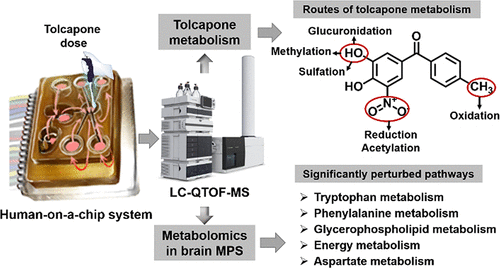当前位置:
X-MOL 学术
›
Anal. Chem.
›
论文详情
Our official English website, www.x-mol.net, welcomes your
feedback! (Note: you will need to create a separate account there.)
Analysis of an Integrated Human Multiorgan Microphysiological System for Combined Tolcapone Metabolism and Brain Metabolomics.
Analytical Chemistry ( IF 6.7 ) Pub Date : 2019-06-10 00:00:00 , DOI: 10.1021/acs.analchem.9b02224 Xin Wang , Murat Cirit , John S. Wishnok , Linda G. Griffith , Steven R. Tannenbaum
Analytical Chemistry ( IF 6.7 ) Pub Date : 2019-06-10 00:00:00 , DOI: 10.1021/acs.analchem.9b02224 Xin Wang , Murat Cirit , John S. Wishnok , Linda G. Griffith , Steven R. Tannenbaum

|
Human-on-a-chip systems are rapidly advancing due to the availability of human stem cells from a variety of tissues, but publications have utilized mostly simple methods of biochemical analysis. Here, we apply mass spectrometry to a sophisticated multiorgan human-on-a-chip system for the comprehensive study of tolcapone metabolite profiling and metabolomics. The developed human-on-a-chip includes seven interacting microphysiological systems (MPSs), brain, pancreas, liver, lung, heart, gut, and endometrium, with a mixer chamber for systemic circulation and tolcapone dose. We investigated tolcapone metabolism by analyzing the circulating medium using mass spectrometry. Twelve tolcapone metabolites were identified, three of which are newly reported. These metabolites demonstrated that oxidation, reduction, and conjugation reactions were the most important routes of tolcapone metabolism. In parallel, metabolomics in brain MPS evaluated the tolcapone influences on endogenous pathways in human brain. Untargeted metabolomics identified 18 key biomarkers significantly changed in human brain MPS after tolcapone dosing, which were mainly associated with perturbation of tryptophan and phenylalanine metabolism (BH4 cycle), glycerophospholipid metabolism, energy metabolism, and aspartate metabolism. This is the first example of successfully combining drug metabolism, metabolomics, and cell engineering to capture complex human physiology and the multiorgan interactions; the results we present here could be a step toward using analytical chemistry to advance the utilization of human-on-a-chip for testing both drug efficacy and toxicity in a single system.
中文翻译:

整合的托卡酮代谢和脑代谢组学的人类多器官微生理系统综合分析。
芯片上人的系统由于来自各种组织的人干细胞的可用性而在迅速发展,但是出版物已经利用了大多数简单的生化分析方法。在这里,我们将质谱应用于复杂的多器官人类芯片系统上,以全面研究托卡朋代谢物谱和代谢组学。已开发的单芯片人包括七个相互作用的微生理系统(MPS),脑,胰腺,肝,肺,心脏,肠和子宫内膜,以及用于系统循环和托卡朋剂量的混合器室。我们通过使用质谱分析循环介质来研究托卡朋代谢。鉴定了十二种托卡酮代谢物,其中三种是新报道的。这些代谢物表明,氧化,还原,结合反应是托卡朋代谢的最重要途径。同时,大脑MPS中的代谢组学评估了托卡朋对人脑内源性途径的影响。未靶向的代谢组学确定了托卡朋给药后人脑MPS中的18个关键生物标志物发生了显着变化,这主要与色氨酸和苯丙氨酸代谢(BH)的扰动有关4个周期),甘油磷脂代谢,能量代谢和天门冬氨酸代谢。这是成功地将药物代谢,代谢组学和细胞工程相结合以捕获复杂的人类生理学和多器官相互作用的第一个例子;我们在这里提出的结果可能是朝着使用分析化学迈进的一步,以促进单芯片人在单个系统中同时测试药物功效和毒性。
更新日期:2019-06-10
中文翻译:

整合的托卡酮代谢和脑代谢组学的人类多器官微生理系统综合分析。
芯片上人的系统由于来自各种组织的人干细胞的可用性而在迅速发展,但是出版物已经利用了大多数简单的生化分析方法。在这里,我们将质谱应用于复杂的多器官人类芯片系统上,以全面研究托卡朋代谢物谱和代谢组学。已开发的单芯片人包括七个相互作用的微生理系统(MPS),脑,胰腺,肝,肺,心脏,肠和子宫内膜,以及用于系统循环和托卡朋剂量的混合器室。我们通过使用质谱分析循环介质来研究托卡朋代谢。鉴定了十二种托卡酮代谢物,其中三种是新报道的。这些代谢物表明,氧化,还原,结合反应是托卡朋代谢的最重要途径。同时,大脑MPS中的代谢组学评估了托卡朋对人脑内源性途径的影响。未靶向的代谢组学确定了托卡朋给药后人脑MPS中的18个关键生物标志物发生了显着变化,这主要与色氨酸和苯丙氨酸代谢(BH)的扰动有关4个周期),甘油磷脂代谢,能量代谢和天门冬氨酸代谢。这是成功地将药物代谢,代谢组学和细胞工程相结合以捕获复杂的人类生理学和多器官相互作用的第一个例子;我们在这里提出的结果可能是朝着使用分析化学迈进的一步,以促进单芯片人在单个系统中同时测试药物功效和毒性。































 京公网安备 11010802027423号
京公网安备 11010802027423号